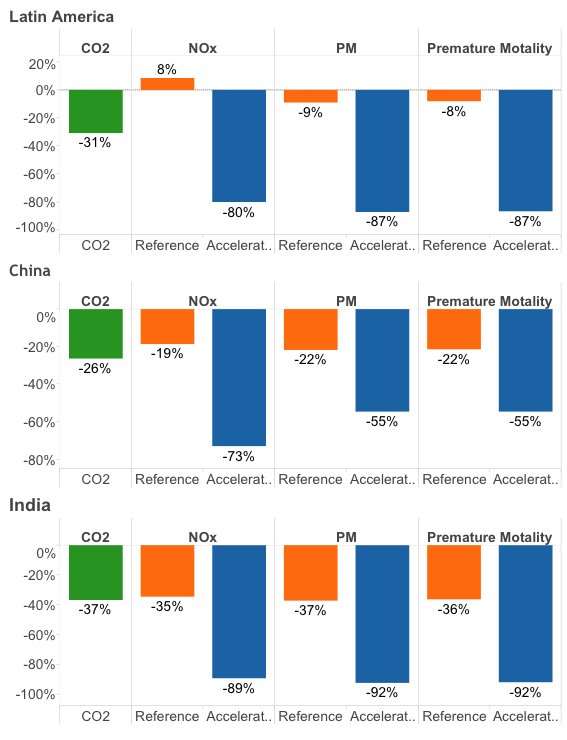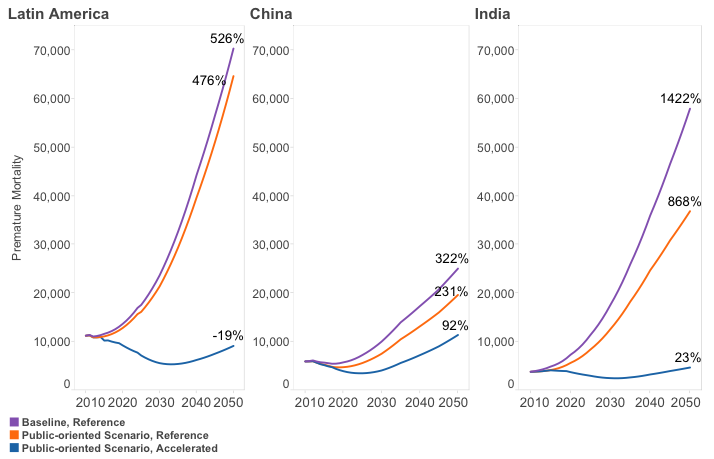Blog
Exploring the climate and health benefits from public transit
As the world rapidly becomes more motorized and more urban, it faces an increasingly urgent dilemma: how to move people efficiently while improving air quality and reducing climate impacts. In high-density urban environments, public transit investments, less reliance on private automobiles, and vehicle emission controls equivalent to Euro 6/VI standards can offer an escape from that dilemma.
This conclusion is important to many cities evaluating expanded bus systems as part of their strategy to reduce climate change and improve public health. Latin American Mayors met last month in Buenos Aires to announce the C40 City Clean Bus Declaration of Intent and a Latin American Cities Declaration on the Compact of Mayors, committing to introduce clean buses and reduce transportation emissions. In order to maximize climate and health benefits from public transit, the latest emission control technologies for buses that meet Euro VI-equivalent standards need to be adopted.
This conclusion is supported by a joint analysis by the ICCT and the International Transportation Forum (ITF), documented in the ITF Transport Outlook 2015. Besides evaluating transportation trends through 2050, this year’s Transport Outlook examines emissions of CO2 and local air pollutants under different urbanization scenarios in Latin America, China and India. Based on an analysis and methodology developed by the ICCT, three metrics were evaluated: emissions of nitrogen oxides (NOx), which contribute to smog and secondary particulate matter (PM) in urban areas; primary PM2.5 emissions, a major factor in both reduced visibility (haze) and serious air-quality-related health problems; and premature mortality in urban areas resulting from primary PM2.5.
Urbanization, when combined with smart growth policies, creates opportunities to move people more efficiently and with lower climate impacts. When complemented by proper land-use planning, a well-operated public transit system is more sustainable than private motorized transportation, in particular in dense and congested areas. Public transit typically consumes less fuel per passenger-km, and thus emits less carbon dioxide, the most significant greenhouse gas. Development and improvement of transit systems can provide for a significant expansion in personal mobility in urban areas while alleviating congestion and mitigating climate change.
As more people move to large urban centers with poor air quality, greater exposure to local air pollutants such as fine particulate matter will result in adverse health impacts, including cardiovascular and pulmonary diseases. Transportation is one of the main factors in poor urban air quality, and heavy trucks and buses typically account for the large majority of air pollutant emissions from transportation in urban areas. While investments in public transit are almost always an effective climate change mitigation strategy, unless transit vehicles are equipped with adequate exhaust emission controls they may still have a negative impact on public health. These controls, necessitated by stringent vehicle emission and fuel standards in many developed countries, can eliminate over 99% of some local air pollutants from engines. Some alternative fuels, such as natural gas, can also reduce emission rates when compared to diesel buses with equivalent emission controls.
Bus rapid transit (BRT) and other types of bus service can play a critical role in climate change mitigation due to their lower cost when compared to mass rail transit. The ITF Transport Outlook 2015 shows large reductions in CO2 emissions under public transport-oriented urbanization scenarios. Figure 1 illustrates differences in 2050 between ITF’s public-oriented, low-road scenario (i.e., high investment in public transit and low investment in road building), and a baseline scenario (i.e., business as usual). CO2 emissions are expected to decrease between 26% and 37% (green bars) depending on the region by shifting activity from private to public transportation, or specifically, BRT and bus transit.

Figure 1. Variations in emissions and health impacts from public transit-oriented scenarios in 2050 (adapted from Figure 4.24, 4.26 and 4.28 in ITF Transport Outlook 2015)
Benefits in terms of local air pollutants and health impacts are limited without stringent vehicle emission controls, assuming primarily diesel buses (orange bars). In Latin America, significantly increasing the number of public buses without corresponding improvements in emission control standards could result in an increase in NOx emissions in 2050 compared to the baseline scenario. This is mostly a result of higher emission rates from diesel buses not equipped with advanced emission controls. The implementation of advanced vehicle emission standards (blue bars) would substantially decrease emissions of local air pollutants and related premature mortality, reaching reductions of up to 92% compared to the baseline scenario in 2050.
Health impact trends over time in these urbanization and technology scenarios can also generate important insights (Figure 2). Baseline premature mortality (purple lines) will increase tremendously in the next decades, reaching 3 to 14 times today’s levels depending on the region. Although the expansion of public transit without advanced emission controls (orange lines) will reduce premature mortality when compared to the baseline scenario, absolute levels will still increase substantially from current levels. The relative difference from the baseline scenario is driven by current rates of vehicle emission controls, mode splits, and activity growth rates. In turn, the implementation of advanced standards for emission controls together with expanded public transit (blue lines)could significantly limit the increase in premature mortality from transportation emissions, even with the rapid increase in transportation demand. In the case of Latin America, premature mortality would be 19% lower than today’s levels.

Figure 2. Trends in premature mortality from different urbanization and technology scenarios
For all regions analyzed, expanding public transit systems will only bring significant health benefits if coupled with regulations that assure improvement in bus emission controls. More broadly, integrated policies aiming to mitigate both climate and health impacts work best. It is possible to mitigate climate change and lower health impacts through less reliance on private automobiles, reduced urban sprawl, higher rates of public transit, and stringent vehicle emission controls.
